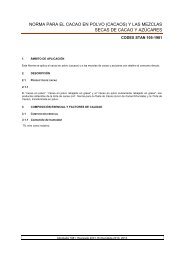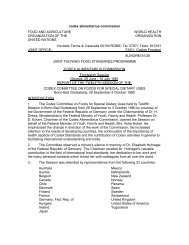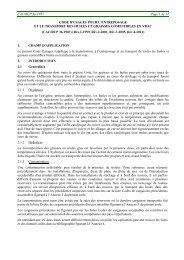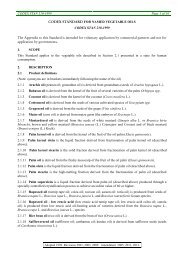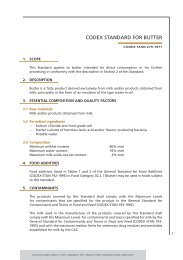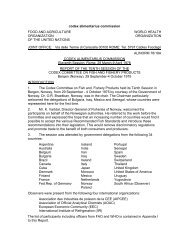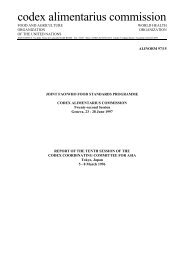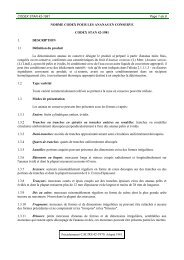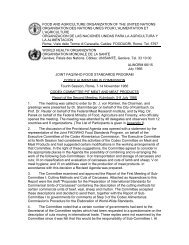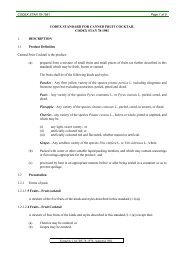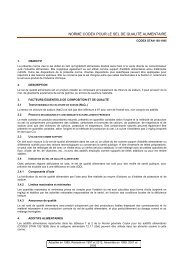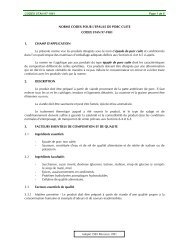REP13/FH JOINT FAO/WHO FOOD STANDARDS PROGRAMME ...
REP13/FH JOINT FAO/WHO FOOD STANDARDS PROGRAMME ...
REP13/FH JOINT FAO/WHO FOOD STANDARDS PROGRAMME ...
You also want an ePaper? Increase the reach of your titles
YUMPU automatically turns print PDFs into web optimized ePapers that Google loves.
<strong>REP13</strong>/<strong>FH</strong> Appendix IV 54<br />
Medical examination of agricultural workers should be carried out if clinically or epidemiologically<br />
indicated.<br />
3.2.3.3 Personal cleanliness<br />
When personnel are permitted to continue working with cuts and wounds covered by waterproof dressings,<br />
they should wear gloves to cover the bandages thereby providing a secondary barrier between them and the<br />
berries they handle or, otherwise they should be reassigned to another working area where they do not<br />
handle berries directly.<br />
3.2.4 Equipment associated with growing and harvesting<br />
Standard operating practices should be developed for the maintenance, cleaning and disinfecting operations<br />
of growing and harvesting equipment, which include the following:<br />
Containers used repeatedly during harvest should be cleaned after each load.<br />
Containers (including liners of containers made from biodegradable materials) that are no longer<br />
cleanable should be disposed of since they may increase the risk of microbial contamination of<br />
berries.<br />
Harvesting containers should not be placed directly on the ground.<br />
If the containers are stored outside, they should be cleaned and disinfected before being used to<br />
transport berries.<br />
3.3 Handling, Storage and Transport<br />
Some berries may have high respiration rates making them more perishable. Enzymes and biochemical<br />
reactions play an important role in the ripening process but also accelerate spoilage of damaged fruits and<br />
increase susceptibility of berries to microbial contamination.<br />
Growers should implement safe handling, transport and storage practices and immediately cool berries after<br />
harvesting. Precooling (i.e., rapid removal of field heat) berries after harvesting (e.g. within the first 2 hours)<br />
is important to maintain freshness and quality and contributes to the control of foodborne pathogens. When<br />
required, growers should use potable water for ice and hydrocooler when precooling to minimize risks of<br />
contamination.<br />
Manual harvest considerations:<br />
o Appearance and firmness of berries are commonly associated with fruit quality and freshness. Over<br />
handling the berries may damage and affect fruit quality. Moreover, adverse temperatures during<br />
harvesting in hot and/or humid weather also decreases quality and may affect food safety due to<br />
fruit damage and juice leakage, which may spread contamination over healthy fruits.<br />
o Growers should have a responsible person to supervise harvesting at all times to assure<br />
harvesters use proper hand washing and follow procedures not to harvest wet, bruised and/or<br />
damaged fruits. Additionally, berries that have fallen on the ground should be discarded unless<br />
they are processed with a microbiocidal step.<br />
o Growers should take measures to train agricultural workers on safe handling, transport and storage<br />
practices to ensure that berries are immediately cooled after harvesting.<br />
Mechanical harvest considerations:<br />
o Mechanical harvest is a common practice for some berries and may create food safety hazards if<br />
the equipment breaks down during the harvest, if it has received poor maintenance and cleaning or<br />
if it damages the fruit.<br />
o Growers should avoid moving harvesting equipment across fields where manure or compost was<br />
applied.<br />
o Before and after harvesting growers should perform proper cleaning and disinfection of all surfaces<br />
of equipments that have been in contact with berries. Moreover harvesting equipment should be<br />
cleaned and disinfected seasonally or as needed (e.g. if the equipment runs over an area with<br />
heavy animal intrusion and faecal deposits).



